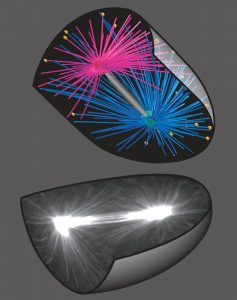A matter of force
Researchers work out the mechanics of asymmetric cell division

When a cell divides, normally the result is two identical daughter cells. In some cases however, cell division leads to two cells with different properties. This is called asymmetric cell division and plays an important role in embryonic development and the self-renewal of stem cells. Researchers from the European Molecular Biology Laboratory (EMBL) have now worked out the mechanism underlying asymmetric cell division in nematode worms. The study, which is published in the current issue of Cell, reveals that interactions between the mitotic spindle and the cell cortex are crucial for asymmetric division.
Soon after the egg cell has been fertilized, the developing embryo of the nematode worm Caenorhabditis elegans undergoes its first cell division. The division gives rise to a bigger cell at the anterior end of the embryo, where the head will develop, and a smaller cell at the posterior end. For this asymmetric division to take place, the mitotic spindle, the apparatus that separates a cell’s chromosomes, needs to be located not centrally but towards the posterior of the egg. The cellular structures that make sure the spindle gets to the right place are protein filaments called microtubules. They are dynamic structures that constantly grow and shrink by adding on or taking off individual building blocks.
“Just before cell division the mitotic spindle moves towards the posterior of the cell while oscillating up and down,” says François Nédélec, group leader at EMBL. “We wanted to find out the mechanisms of this motion and explore its properties.”
Nédélec and his group combined computer simulations with microscopy studies to test the predictions made about microtubule behaviour experimentally. This approach revealed that the interaction of the microtubules forming the mitotic spindle and the cell cortex, a structure lining the cell just beneath the plasma membrane, most likely brings about the correct positioning of the spindle towards the posterior of the cell. The microtubules grow until they reach the borders of the cell and touch the cortex. Upon contact with the cortex, the filaments immediately start to shrink.
“This shrinkage is then translated into a pulling force at the cortex,” says Cleopatra Kozlowski from Nédélec’s group, who carried out the research together with Martin Srayko from the Max Planck Institute of Molecular Cell Biology and Genetics. “How exactly this works we don’t know yet. One possibility could be that part of the cortex holds on to the microtubule while it shortens, and so pulls on the whole spindle.”
The nature of so-called force generators on the cortex is yet unclear, as is the question if more of them are active at the posterior to give more net force in that direction. But computer simulations show that the concept of force generators that translate the dynamic behaviour of microtubules into a pulling force can explain the specific movements of the mitotic spindle.
The same principle might apply also to asymmetric cell division in other organisms and contexts, such as stem cell renewal. The cellular components involved in such divisions have been conserved throughout evolution making it likely that different species might also share the mechanism of the process.



